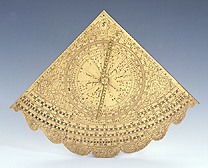
 |
| Catalogue |
 |
 Quadrant Above the hour diagram, the quarter hour division scale of this acting as the division, the projection is filled by the names of twenty seven of a numbered list of 31 star names marked on the instrument. The names are written at right angles to the sense in which the rest of the instrument is read, presumably so that they may be consulted more easily in relation with the scales on the reverse side of the instrument which read in a similar sense. The list of stars as given on the instrument is (within the projection, all are engraved in small capitals): 'Corona borealis 23', 'Gemini seqvens 9', 'Cvrs Pegasi 30', 'Cervix Leonis 13', 'Pleiades 2', 'Artvrvs 20', 'Cauda Leonis 15', 'Ocvlvs Tauri 3', 'Cor Leonis 12', 'Ala{tus} Pegasi 31', 'Aquila 26', 'Canicvla 10', 'Dexter Hvmer{us} Orionus 6', 'Hydra 11', 'Lanx Borialior 22', 'Spica 17', 'Sinister Pes Orionis 5', 'Venter C?ti 1', 'Lanx Australior 21', 'Cannis maior 7', 'Cavda capricorni 28', 'Cor scorpio 24', 'Ospiscis Astra 29', 'Hirc{us} 4', 'Sign{us} 27', 'Lira 28', 'Prece 8'; outside the projection: 'Extremv{m} Cav{da} Vr 19', 'Mediv{m} cauda? Vr{sa} Ma{jor} 18', 'Dorsv{m} Vrse ma{jor} 14', 'Prima cauda? 16'. Surrounding the upper part of the projection is a rectangular protractor type scale, its radial lines centred on a hole placed at the centre of the 0 (equator) line of the projection. The hole was presumably the attachment point for a thread cursor or a brachiolus. This scale which reads to 1? by alternately hatched and unhatched divisions is graduated 0 to 90 to 40 within the divisions, and 75 to 0 to 50 outside them, the 0 / 90 division being placed on the centre (6 o'clock) line of the instrument which is marked 'AUSTRVM [star] BOREAS'. Above the outer series of numbers is the italic inscription 'Declinationes ab ?quatore'. An additional strip of brass riveted along the top edge of the instrument to form a raised rim along which an arm or some form of simple rete (now missing) could slide. Engraved on this strip are the latitudes of 'Londinv{m} 52', 'Bristo [Bristowe ?] 53', 'Eboracv{m} [York] 55', 'Barwick 57', 'Edinbvrg 58'. Approximately 6 mm below this on the edge lines of the instrument are the remains of two rivets, possibly the attachment points for sights or another attachment. There are two further holes 19 mm apart at the bottom of the right hand edge, and a third hole at 8? on the meridian line. On the reverse the centre of the instrument is filled by a zodiacal calendar (with 0? Aries at 10 March) the zodiac signs divided to 2?, the months to 2 days by divisions and to single units by dots within these. Within the calendar, and concentric with it is a 24 hour scale reading to 15 minutes and the centre of the circle is divided into twelve sectors, the dividing lines of which are sequentially labelled A to F twice. Within these sectors, beginning from sector A at the 0 / 24 point of the hour scale are the numbers of all the stars listed in the face of the instrument and, where space permits, the names of fourteen of them. Along the two edges and radial from the centre of the calendar is an undivided scale of 231/2 presumably for solar declination, reading from 0 towards the apex of the instrument, 231/2 falling on the centre line. Below the calendar are three scales labelled 'A', 'L' and 'G', that marked 'A' being split with its two end sections placed above the 'L' and 'G' scales, its central portion below. The 'A' scale, which is numbered above and below the alternately hatched and unhatched divisions of each unit into four parts 0 to 6 / 6 to 12 to 6 / 6 to 0 and 0 to 23 / 24 to 48 to 24 / 24 to 0 is marked in the left hand sectors of the scale 'R{ecta}' and in the right, 'V{ersa}'. The 'L' scale which is engraved in the opposite direction from the other scales so that it reads from the apex of the instrument and not from the limb is divided 48 to 0 to 48, 0 being on the centre line of the instrument. The 'G' scale is a single sequential scale of 90? reading to 1?. The letters distinguishing the three scales presumably stand for 'A{ltimetria}', 'L{ongometria}' and 'G{raduum}' or 'G{eometria}'. The three scales are further distinguished from each other visually by different forms of hatching, the Altimetria scale in its three sections using parallel horizontal lines, the Longometria scale diagonal strokes and the Geometric or degree scale small squares. All the remaining free space on the surface is filled with symmetrical foliate decoration surrounding an empty escutcheon in the apex, and the letters 'A.D.' on either side of the centre line at the bottom of the instrument. At the centre of the calendar is a double rule decorated with solid leaf decoration on a hatched ground. A highly unusual instrument of considerable sophistication which stylistically would seem to have been made by a Flemish or Flemish-trained engraver working in the Spanish Habsburg dominion of Naples (cf. the documented example of Cornelius Vinch or Vinckx). The unexpected series of British place-names inscribed on the instrument might be explained by the hypothesis that the instrument was made to the order of, or (as its complexity might suggest), as a presentation piece to a Neapolitan or Spanish courtier expecting to follow Philip II of Spain to England on the occasion of his marriage to Mary Tudor. The careful distribution of the places named throughout Britain and the fact that they are all places of strategic importance, would tend to support this suggestion. Anthony J. Turner |



